| Title | Pages |
|---|---|
| Determination of Total Phenolic Compounds, Antioxidant Activity and Ferulic Acid in Extracts of Sugar Beet Pulp In the resent research, two extracts (methanol and NaOH (0.5 molL-1)) were analyzed for the total phenolic contents (TPC), ferulic acid concentration and antioxidant activity. Results revealed that significant differences were found in TPC among different extracts and alkaline extracts contained higher amounts of polyphenols than methanolic extract. The ferulic acid concentration in the solvent and alkaline liquor varied according to extraction time and there were no significant differences between the ferulic acid concentration for all methanolic treatments. Antioxidant capacity for extracts were shown that the significant differences were found at a level of (p < 0.05) between all extracts and correlation coefficient (r2 = 0.82) showed that total phenolic content was responsible for antiradical efficiency in sugar beet pulp extracts. Our results strongly suggest sugar beet pulp extracts can be promising sources of potential antioxidants that can be used as additive in food industry. 
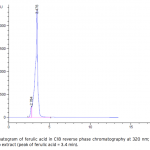
|
251 - 257 |
| Composition of the Volatile Oils of Anthemis coelopoda var. coelopoda from Turkey In this study, hydro distilled essential oils derived from the aerial parts of Anthemis coelopoda var. coelo- poda (Asteraceae) grown in Turkey were analysed by GC and GC-MS system. Fifty seven components were identified representing 90.7% of the oils. It was determined that Anthemis coelopoda var. coelopoda essential oil contained b-caryophyllene (21.8%), nerolidol (10.8%), azulene (9.5%), borneol (5.5%), linalool (4.3%) and cyclopentadecane (4.2%) as major compounds. Essential oil analysis of the Anthemis coelopoda var. coelopoda has shown that it has b-caryophyllene/nerolidol and azulene chemotype. 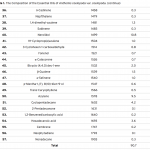
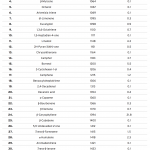
|
259 - 265 |
| Breeding Performance of the Red-Backed Shrikes (Lanius collurio) in a Riparian Habitat We investigated the breeding performance and nest site properties of the red-backed shrikes in a small population in Nallihan Bird Sanctuary in Turkey. We carried out the field studies during the 2006 and 2007 breeding seasons. We monitored 12 nests of 7 breeding pairs in the 2007 breeding season. Most of the territories were near the Aladag Stream-Riparian Habitat. The distance between the nests were 110 ± 20 m. The red-backed shrikes built their nests in the thorny bushes at the average height of 80 ± 32.5 cm above the ground. Only one pair could raise fledglings within the monitored pairs. Four Nests were predated during the incubation and four nests were predated during nestling stage in the 2007 breeding season. Yet, the previous year we had detected at least one fledgling within 6 of the 8 territories. We estimated that this small popula- tion had suffered from high nest predation at the Nallihan Bird Sanctuary after a successful breeding season. Long-term studies are required to obtain more detailed information about the populations of the red-backed shrikes in Turkey. 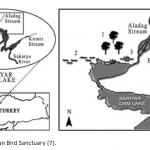
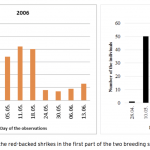
|
267 - 271 |
| A new epitype specimen for Campanula peshmenii Güner In this study, a new type (epitype) specimen for Campanula peshmenii Güner is determined. Detailed descripti- on and conservation status of this species are given. This study also contained SEM images and photographs of pollen, seed, hairs of corolla, and stylus, holotype and epitype specimen, habitat, flowering, and fruiting shape of habitus. 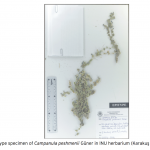
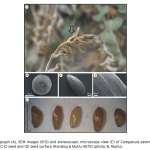
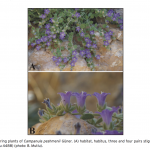
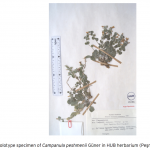
|
273 - 278 |
| A Study on The Male and Female Genıtal Structures of Two Cortodera Species (Coleoptera: Cerambycidae) From Turkey In this study, the male and female genital structures of Cortodera flavimana (Waltl, 1838) and the female geni- tal structures of Cortodera colchica Reitter, 1890 were examined. Three females of C. colchica were collected in the city of Ankara, Konya and Sivas, in June 14, 2011, June 6, 2009 and June 22, 2011. Five males and two females of C. flavimana were collected in the city of Eskişehir, Yozgat, Çankırı and Sivas, in June 16, 2010, May 26, 2011, June 4, 2011 and June 22, 2011. Description and drawings of male and female genital structures of C. flavimana and the female genital structures of C. colchica are given in details for the first time. 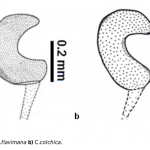

|
279 - 282 |
| Evaluating the Effects of Sourdough, Bakery Yeast and Sodium Bicarbonate on Texture, Volatile Compounds and Staling of Barbari Bread There are various methods to process dough for bread production. In this study, sourdough, bakery yeast, sodium bicarbonate and a combination of bakery yeast and sodium bicarbonate were used to produce dough of Barbari bread. The structure of the texture of bread, bread staling and volatile compounds of bread samples were analyzed. The results showed that the texture of treated bread samples with a combination of bakery yeast and sodium bicarbonate had less hardness and were stale later. Generally, 33 volatile compounds were observed in this type of bread. Most of these compounds were aldehyde, alcohol, and ketones compounds. 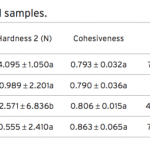

|
283 - 293 |
| The Role of Different Metal and Heavy Metal Ions on Chromium Reduction by Pseudomonas mendocina DS0601- FX-P22 In this study, the effects of different metal ions such as Mn2+, Cu2+, Fe2+, Ba2+, Al3+, Ni2+, Co2+, Zn2+, Cd2+ and Pb2+ on the bacterial chromium reduction by Pseudomonas mendocina DS0601-FX-P22 were investigated. Two dif- ferent initial chromium concentrations (15 mg/L and 25 mg/L Cr(VI)) were studied. The Cr(VI) reduction ability of the bacterium increased in the presence of metal ions like Cu2+ and Fe2+ and was significantly inhibited in the presence of metal ions like Ba2+ and Ni2+. Also, Cu2+ was the most efficient metal ion at Cr(VI) reduction for both Cr(VI) concentration (15 and 25 mg/L) in P. mendocina DS0601-FX-P22 bacterium. 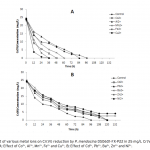
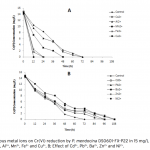
|
295 - 300 |
| Medical Characteristics of Arid-Semi Arid Truffle (Terfezia and Picoa) in the Elazığ-Malatya region of Turkey In this study, the antimicrobial and antioxidant activity of Terfezia boudieri, T. claveryi, T. olbiensis, Picoa le- febvrei and P. juniperi were investigated. It was determined that the methyl alcohol extraction of T. boudieri, T. claveryi, T. olbiensis, P. lefebvrei and P. juniperi inhibit the development of E. coli, B. subtilis, P. aeruginosa, S. aureus, S. mutans, P. vulgaris, S. typhi, C. tropicalis and Trichophyton sp. at various levels (8 mm to 22 mm diameter) and their effect to remove the DPPH radical was more efficient at groups to which samples of 25 μL (1.22% to 2.58%), 50 μL (2.31% to 3.28%) and 100 μL (5.24% to 8.00%) were added. It was determined that methyl alcohol that was extracted from Terfezia species were more effective than Picoa species against test microorganisms. When the groups were compared in terms of concentration, the highest level of free radical scavenging effect at the group, to which we added a 100 μL sample, was seen at T. boudieri with 8.00%. 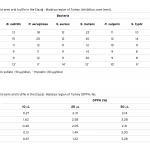
|
301 - 308 |
| Synthesis, Reactions, Spectral Behavior and Biological Evaluation of Some New D-Glucopyranoside Derivatives as Potential Antimicrobial Agents IIn the present investigation, a new series of methyl 6-O-cinnamoyl-α-D-glucopyranoside derivatives were synthesized by the reaction of methyl α-D-glucopyranoside (1) with various non-traditional acylating agents in pyridine at -5°C. For this purpose, firstly, selective cinnamoylation of methyl α-D-glucopyranoside (1) has been carried out by the direct acylation method and afforded the methyl 6-O-cinnamoyl-α-D-glucopyranoside (2) in good yield. Secondly, in order to obtain newer products for antimicrobial screening studies, the 6-O-cinnamoyl derivative was further transformed to a series of 2,3,4-tri-O-acyl derivatives (4-14) containing a wide variety of functionalities in a single molecular framework. The structures of the newly synthesized compounds were characterized by IR, NMR and physicochemical properties analyses. All the compounds were evaluated for their in vitro antibacterial and antifungal activities using the disc diffusion and food poisoning methods. The study revealed that the compound methyl 6-O-cinnamoyl-2,3,4-tri-O-decanoyl-α-D-glucopyranoside (7) showed the highest inhibition activity against both Gram (+) B. subtilis and Gram (-) P. aeruginosa microorganisms. The tested compound methyl 6-O-cinnamoyl-2,3,4-tri-O-lauroyl-α-D-glucopyranoside (8) exhibited maximum mycelial growth inhibition against A. niger fungi. The acylated derivatives were found to be more effective against the fungal strains than those of the bacterial pathogens. This is the first report of the antimicrobial activity of the selected chemicals against the selected pathogens. 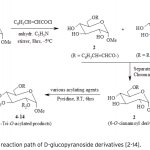
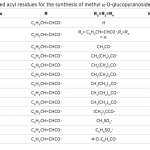
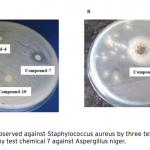

|
309 - 322 |
| Interactions with Climate and Ecosystem of Saharan Dust Dynamics North African deserts are the world’s largest sources of atmospheric mineral dust produced by aeolian. In this study the impact of various growth media on development of some bread wheat (Triticum aestivum L.) and durum wheat (Triticum durum L.) cultivars have been investigated. As a four different nutrient media, Hewitt nutrient solution [1], illuminated and non-illuminated Saharan desert soil solutions and distilled water have been utilized. Shoot length (cm.seedling-1), leaf area (cm2 seedling-1) and photosynthetic pigments [chlo- rophyll a, chlorophyll b and carotenoids, mg ml-1 g fresh weight (g fw)-1] have been determined. The results of this study indicate that, wheat varieties fed by irradiated Saharan soil solution gave comparable results to Hewitt nutrient solution. 

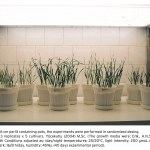
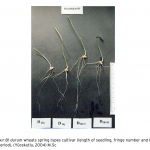
|
323 - 328 |